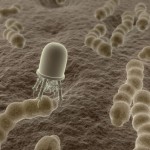
http://www.techwall.org
As technology in the bioscientific realm advances, there is an emerging body of law pertaining to patents on biological material, which focuses squarely on the hotly contested areas of personalized medicine and nanotechnology. Personalized medicine is the practice of creating therapies for the specific genetic profiles of patients and their diseased cells. Examples of the nanotechnology involved include cancer treatment, bio sensors, bio markers, bio imaging, and drug delivery systems. The controversies are beginning to form and the potential for litigation is building. Are these inventions worthy of patent protection? What happens to these particles after they perform the specific task they were designed to carry out? Is it a health issue, environmental issue, both? These are the types of inquiries I am interested in exploring. By no means do I purport to have expertise in ANY of the myriad fields I plan to touch on, but I am curious, though, and look forward to initiating a robust dialogue with those who are experts or those who are passionate about the direction of the law in these areas.
With that being said, I would like to begin with a broad and general overview of the current patentability issues. The first hurdle in the patent process is actually having something that is patentable subject matter. The nexus of the debate is 35 U.S.C. § 101 which provides: “Whoever invents or discovers any new and useful process, machine, manufacture, or composition of matter, or any new and useful improvement thereof, may obtain a patent thereof, subject to the conditions and requirements of this title.” The statute is inherently ambiguous and has enjoyed broad interpretation, when applied by the courts, to determine if something is actually patentable subject matter. See, e.g., Diamond v. Chakrabarty, 447 U.S. 303, 309 (1980) (statutory subject matter “include[s] anything under the sun that is made by man.”). However, the statute does not afford limitless possibilities and probabilities to the inventors of the world.
There are three specific categories that are off limits to the powers afforded by obtaining a patent: the laws of nature, physical phenomena, and abstract ideas. Diamond v. Diehr, 450 U.S. 175, 185 (1981). The primary reasoning for unpatentability was articulated in Gottschalk v. Benson, 409 U.S. 63, 67 (1972), whereby the Court reasoned that, although these three categories could be discovered, they ultimately “are the basic tools of scientific and technological work.” The rationale is simple, if these basic building blocks of nature were allowed the protective rights of a patent, specifically the right to exclude others from practicing the inventions or discoveries, the world of research would be drastically encumbered and hindered. These excluded categories, the basic building blocks, are utilized by scientists, inventors, and theorists to create patentable subject matter.
While the discovery of any of the three excluded categories does not qualify for patentability, the application of them that leads to a new and useful process, machine, manufacture, or composition of matter, may very well lead to a patent, including those that have helped to fuel the explosion of scientific research in biotechnology. Diehr, 450 U.S. at 187. Those developments have spawned the creation of personalized medicine. Science is moving forward and is forcing the law to keep pace.
The paradigm to determine the patentability of nanotechnology related to biological material might be altered in the near future due to the Supreme Court hearing the case of In re Bilski (the discussion of this case and the implications of the opinion has the potential to occupy many future posts). The Court heard oral arguments on In re Bilski on November 9, 2009, and the forthcoming opinion in that matter will have an impact on the patentability of processes, including those that have helped to fuel the explosion of scientific research in biotechnology. As a result, the development of personalized medicine hangs in the balance.
In addition to the legal, scientific, and ethical debates, there are the personal policy concerns. A few worth mentioning are those relating to autonomy, freedom to make decisions about resolving/preventing health issues, the right to feel safe about the treatments we receive, and the list goes on. The point I am trying to make is that we are on the precipice of a new era with the interaction of nanotechnology, personalized medicine, and the law, and we stand to gain more than we could ever have imagined or we stand to lose more than we ever bargained for.
Personalized Medicine Coalition,
www.personalizedmedicinecoalition.org/communications/TheCaseforPersonalizedMedicine _5_5_09.pdf
